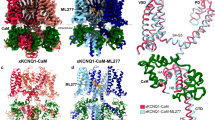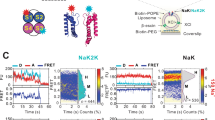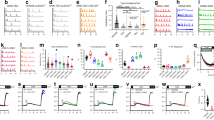Abstract
THE protein IsK (Mr 14,500) is present in epithelial cells1, heart2,3, uterus4 and lymphocytes5 and induces slowly activating K+ currents when expressed in Xenopus oocytes1. The finding that mutations of its single transmembrane segment altered channel gating6 or selectivity7 has suggested that IsK is a channel-forming protein. But IsK does nof exhibit the K+ channel hallmarks8 (a conserved K+ selective pore (H5) flanked by either six9–11 or two12,13 membrane-spanning regions). Here we report that IsK expression in Xenopus oocytes also induces a Cl− selective current very similar to the Cl− current produced by phospholemman expression14 and with biophysical, pharmacological and regulation characteristics very different from those of the IsK-induced K+ channel activity. IsK mutagenesis identifies amino- and carboxy-terminal domains as critical for the induction of Cl− and K+ channel activities, respectively. Our data lead to a model in which the IsK protein (now called IsK, Cl) acts as a potent activator of endogenous and otherwise silent K+ or Cl− channels.
This is a preview of subscription content, access via your institution
Access options
Subscribe to this journal
Receive 51 print issues and online access
$199.00 per year
only $3.90 per issue
Buy this article
- Purchase on Springer Link
- Instant access to full article PDF
Prices may be subject to local taxes which are calculated during checkout
Similar content being viewed by others
References
Takumi, T., Ohkubo, H. & Nakanishi, S. Science 242, 1042–1045 (1988).
Honore, E. et al. EMBO J. 10, 2805–2811 (1991).
Folander, K. et al. Proc. natn. Acad. Sci. U.S.A. 87, 2975–2979 (1990).
Pragnell, M. et al. Neuron 4, 807–812 (1990).
Attali, B. et al. J. biol. Chem. 267, 8650–8657 (1992).
Takumi, T. et al. J. biol. Chem. 266, 22192–22198 (1991).
Goldstein, S. A. N. & Miller, C. Neuron 7, 403–408 (1991).
Aldrich, R. Nature 362, 107–108 (1993).
Jan, L. Y. & Jan, Y. N. A. Rev. Physiol 54, 535–555 (1992).
Pongs, O. Physiol. Rev. 72, S69–S88 (1992).
Rudy, B., Kentros, C. & Vega-Saenz De Miera, E. Molec. cell. Neurosci. 2, 89–102 (1991).
Ho, K. et al. Nature 362, 31–38 (1993).
Kubo, Y., Baldwin, T. J., Jan, Y. N. & Jan, L. Y. Nature 362, 127–133 (1993).
Moorman, J. R., Palmer, C. J., John, J. E., Durieux, M. E. & Jones, L. R. J. biol. Chem. 267, 14551–14554 (1992).
Kreig, P. A. & Melton, D. A. Nucleic Acids Res. 12, 7057–7070 (1984).
Murai, T., Kazikuka, A., Takumi, T., Ohkubo, H. & Nakanishi, S. Biochem. biophys. Res. Commun. 161, 176–181 (1989).
Busch, A. E., Varnum, M., Adelman, J. P. & North, R. A. Biochem. biophys. Res. Commun. 184, 804–810 (1992).
Honoré, E., Attali, B., Lesage, F., Barhanin, J. & Lazdunski, M. Biochem. biophys,. Res. Commun. 184, 1135–1141 (1992).
Busch, A. E., Varnum, M. D., North, R. A. & Adelman, J. P. Science 255, 1705–1707 (1992).
Lesage, F. et al. Receptors Channels 1, 143–152 (1993).
Palmer, C. J., Scott, B. T. & Jones, L. R. J. biol. Chem. 266, 11126–11130 (1991).
Guillemare, E. et al. Biochemistry 31, 12463–12468 (1992).
Author information
Authors and Affiliations
Rights and permissions
About this article
Cite this article
Attali, B., Guillemare, E., Lesage, F. et al. The protein IsK is a dual activator of K+ and CI− channels. Nature 365, 850–852 (1993). https://doi.org/10.1038/365850a0
Received:
Accepted:
Issue Date:
DOI: https://doi.org/10.1038/365850a0
This article is cited by
-
KCNE1 does not shift TMEM16A from a Ca2+ dependent to a voltage dependent Cl- channel and is not expressed in renal proximal tubule
Pflügers Archiv - European Journal of Physiology (2023)
-
Diversity of Cl− Channels
Cellular and Molecular Life Sciences (2006)
-
The conduction pore of a cardiac potassium channel
Nature (1998)
-
A novel mutation in the potassium channel gene KVLQT1 causes the Jervell and Lange-Nielsen cardioauditory syndrome
Nature Genetics (1997)
-
A new wave for heart rhythms
Nature (1996)
Comments
By submitting a comment you agree to abide by our Terms and Community Guidelines. If you find something abusive or that does not comply with our terms or guidelines please flag it as inappropriate.



